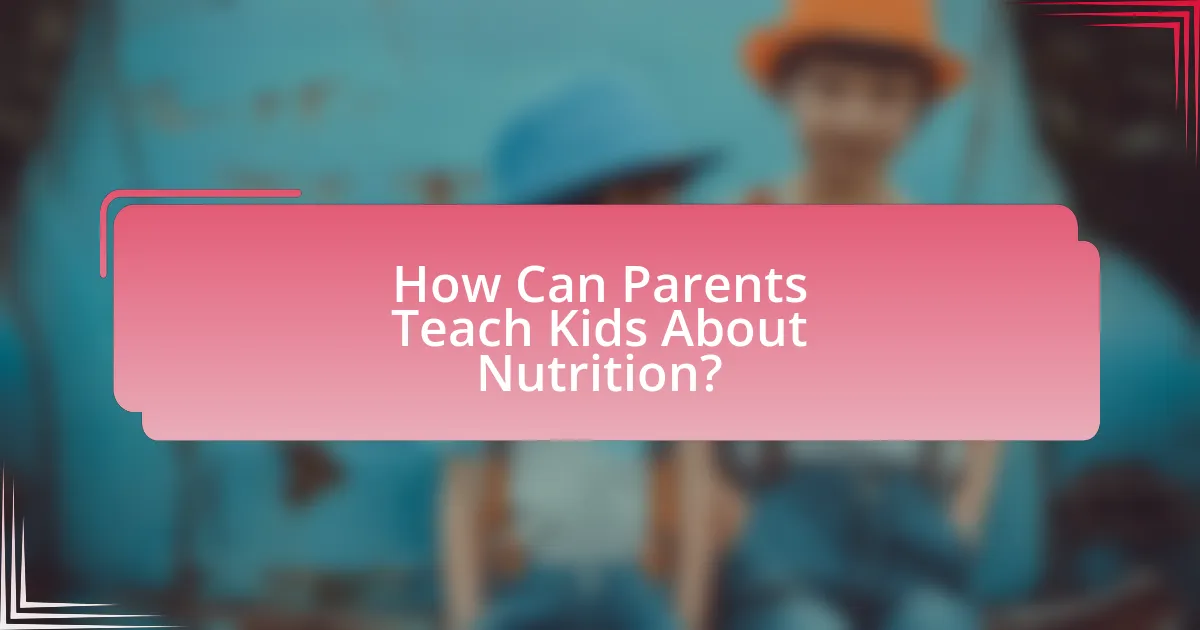The article “Building Healthy Habits: Teaching Kids About Nutrition from an Early Age” focuses on the significance of instilling healthy habits in children, emphasizing the importance of nutrition for their physical, cognitive, and emotional development. It outlines how healthy eating patterns can lead to better academic performance, improved mental health, and reduced risk of chronic diseases. The article discusses practical strategies for parents to educate their children about nutrition, including involving them in meal planning and preparation, understanding portion sizes, and addressing common misconceptions about food. Additionally, it highlights the role of nutrition education in shaping lifelong healthy habits and the essential food groups that children should learn about.

What are Healthy Habits and Why are They Important for Kids?
Healthy habits are behaviors that promote physical, mental, and emotional well-being in children, such as regular exercise, balanced nutrition, adequate sleep, and good hygiene practices. These habits are important for kids because they lay the foundation for a healthy lifestyle, reduce the risk of chronic diseases, and enhance cognitive function and emotional resilience. Research indicates that children who engage in healthy habits are more likely to maintain these behaviors into adulthood, leading to improved health outcomes over their lifetime. For instance, a study published in the Journal of Pediatrics found that children who eat a balanced diet and participate in regular physical activity have better academic performance and lower rates of obesity.
How do healthy habits influence a child’s development?
Healthy habits significantly influence a child’s development by promoting physical health, cognitive function, and emotional well-being. Engaging in regular physical activity, balanced nutrition, and adequate sleep fosters growth, enhances brain development, and improves mood regulation. Research indicates that children who maintain healthy eating patterns are more likely to achieve better academic performance and exhibit improved concentration, as evidenced by a study published in the Journal of School Health, which found that students with higher fruit and vegetable intake scored better on standardized tests. Additionally, consistent exercise has been linked to increased self-esteem and reduced anxiety levels in children, further supporting the importance of healthy habits in overall development.
What specific areas of development are impacted by nutrition?
Nutrition significantly impacts physical, cognitive, and emotional development. Adequate nutrition is essential for physical growth, as it provides the necessary vitamins and minerals that support bone density, muscle development, and overall health. Cognitive development is also influenced by nutrition; for instance, deficiencies in essential fatty acids and micronutrients can impair brain function and learning abilities. Furthermore, nutrition affects emotional development, as a balanced diet can contribute to better mood regulation and mental health. Research indicates that children who receive proper nutrition are more likely to perform better academically and exhibit improved behavior, highlighting the critical role of nutrition in holistic development.
How can early nutrition education shape lifelong habits?
Early nutrition education can significantly shape lifelong habits by instilling knowledge and skills related to healthy eating from a young age. Research indicates that children who receive nutrition education are more likely to make healthier food choices, understand the importance of balanced diets, and develop positive attitudes towards fruits and vegetables. A study published in the Journal of Nutrition Education and Behavior found that children who participated in nutrition education programs showed improved dietary behaviors, such as increased fruit and vegetable consumption, which can lead to long-term health benefits. This foundational knowledge equips children to make informed decisions about their diets throughout their lives, ultimately fostering healthier lifestyles and reducing the risk of diet-related diseases.
What role does nutrition play in a child’s overall health?
Nutrition is essential for a child’s overall health as it directly influences growth, development, and immune function. Adequate nutrition provides the necessary vitamins, minerals, and energy required for physical and cognitive development. For instance, a study published in the “Journal of Nutrition” found that children who consume a balanced diet rich in fruits, vegetables, and whole grains have better academic performance and lower rates of obesity. Furthermore, proper nutrition supports the development of strong bones and muscles, which is crucial during childhood when the body is rapidly growing.
How does proper nutrition affect physical health?
Proper nutrition significantly enhances physical health by providing essential nutrients that support bodily functions and prevent diseases. A balanced diet rich in vitamins, minerals, proteins, and healthy fats contributes to optimal growth, development, and maintenance of bodily systems. For instance, adequate intake of calcium and vitamin D is crucial for bone health, while sufficient protein supports muscle development and repair. Research indicates that children who consume a nutritious diet are less likely to experience obesity, diabetes, and cardiovascular diseases later in life, highlighting the long-term benefits of proper nutrition.
What are the mental health benefits of good nutrition in children?
Good nutrition in children significantly enhances their mental health by improving mood, cognitive function, and emotional regulation. A balanced diet rich in essential nutrients, such as omega-3 fatty acids, vitamins, and minerals, has been linked to lower rates of anxiety and depression among children. For instance, a study published in the journal “Nutrients” found that children who consumed a diet high in fruits, vegetables, and whole grains exhibited better mental well-being and cognitive performance compared to those with a diet high in processed foods. This evidence underscores the importance of good nutrition in fostering positive mental health outcomes in children.

How Can Parents Teach Kids About Nutrition?
Parents can teach kids about nutrition by involving them in meal planning and preparation, which fosters an understanding of healthy food choices. Engaging children in selecting fruits, vegetables, and whole grains helps them learn about balanced diets and the importance of nutrients. Research indicates that children who participate in cooking activities are more likely to develop positive eating habits and a preference for healthier foods. For example, a study published in the Journal of Nutrition Education and Behavior found that children who helped prepare meals were more inclined to try new foods and consume more fruits and vegetables.
What strategies can parents use to introduce nutrition concepts?
Parents can introduce nutrition concepts by engaging children in meal planning and preparation. This hands-on approach helps children understand the importance of healthy food choices and the nutritional value of different ingredients. Research indicates that children who participate in cooking activities are more likely to try new foods and develop healthier eating habits. For example, a study published in the Journal of Nutrition Education and Behavior found that children who helped prepare meals were more inclined to consume fruits and vegetables. Additionally, parents can use educational resources, such as books and interactive apps, to teach children about food groups and balanced diets, reinforcing the concepts learned during cooking activities.
How can cooking together enhance understanding of nutrition?
Cooking together enhances understanding of nutrition by providing hands-on experience with food preparation and ingredient selection. Engaging in cooking activities allows individuals, especially children, to learn about the nutritional value of different foods, portion sizes, and the importance of balanced meals. Research indicates that children who participate in cooking are more likely to make healthier food choices and develop positive attitudes towards fruits and vegetables. A study published in the Journal of Nutrition Education and Behavior found that cooking classes significantly improved children’s knowledge of nutrition and their willingness to try new foods. This practical involvement fosters a deeper comprehension of nutrition concepts, making it easier to apply them in daily life.
What resources are available for teaching kids about healthy eating?
Resources available for teaching kids about healthy eating include educational websites, interactive apps, cookbooks, and community programs. Websites like ChooseMyPlate.gov provide guidelines and resources tailored for children, while apps such as “Fooducate” and “Eat & Move-O-Matic” engage kids in learning about nutrition through games and activities. Cookbooks designed for children, like “The Complete Cookbook for Young Chefs,” offer simple recipes that promote healthy eating habits. Additionally, community programs, such as those offered by local health departments or schools, often include workshops and hands-on activities that teach kids about nutrition and cooking. These resources are effective in fostering an understanding of healthy eating among children.
Why is it important to involve kids in meal planning?
Involving kids in meal planning is important because it fosters healthy eating habits and encourages them to take ownership of their nutrition. When children participate in selecting meals, they are more likely to try new foods and develop a positive relationship with healthy options. Research indicates that children who are engaged in meal preparation are more inclined to consume fruits and vegetables, leading to better dietary choices overall. A study published in the Journal of Nutrition Education and Behavior found that children who helped with meal planning and preparation increased their fruit and vegetable intake by 25%. This active involvement not only enhances their understanding of nutrition but also builds essential life skills.
How does meal planning foster responsibility in children?
Meal planning fosters responsibility in children by involving them in the decision-making process regarding their food choices. When children participate in meal planning, they learn to consider nutritional value, portion sizes, and the importance of balanced meals, which cultivates a sense of accountability for their health. Research indicates that children who engage in meal planning are more likely to develop lifelong healthy eating habits, as they understand the implications of their choices. This active involvement not only enhances their understanding of nutrition but also encourages them to take ownership of their dietary habits, reinforcing the concept of responsibility in their daily lives.
What are the benefits of allowing kids to choose healthy foods?
Allowing kids to choose healthy foods fosters autonomy and encourages lifelong healthy eating habits. When children are involved in selecting their meals, they are more likely to develop a positive relationship with food, leading to better nutritional choices. Research indicates that children who participate in food selection are more inclined to consume fruits and vegetables, which can enhance their overall health and reduce the risk of obesity and related diseases. A study published in the Journal of Nutrition Education and Behavior found that children who had a say in their food choices increased their intake of healthy foods by 25%. This empowerment not only boosts their confidence but also instills a sense of responsibility towards their dietary choices.

What Specific Nutritional Topics Should Be Covered?
Specific nutritional topics that should be covered include the importance of balanced diets, understanding macronutrients (carbohydrates, proteins, and fats), the role of vitamins and minerals, portion control, and the impact of sugar and processed foods on health. Teaching kids about balanced diets helps them learn how to combine different food groups for optimal health. Understanding macronutrients is essential for kids to grasp how different foods fuel their bodies. Discussing vitamins and minerals emphasizes their importance in growth and development. Portion control teaches moderation, while educating about sugar and processed foods raises awareness of their potential negative health effects. These topics are foundational for instilling healthy eating habits in children.
What are the essential food groups children should learn about?
The essential food groups children should learn about are fruits, vegetables, grains, protein, and dairy. These groups provide the necessary nutrients for growth and development. For instance, fruits and vegetables are rich in vitamins and minerals, grains provide energy through carbohydrates, protein sources like meat and beans support muscle growth, and dairy offers calcium for strong bones. Understanding these food groups helps children make informed dietary choices, promoting lifelong healthy eating habits.
How can parents explain the importance of fruits and vegetables?
Parents can explain the importance of fruits and vegetables by highlighting their role in providing essential nutrients that support growth and overall health. Fruits and vegetables are rich in vitamins, minerals, and fiber, which are crucial for developing strong immune systems, maintaining healthy digestion, and preventing chronic diseases. For instance, a diet high in fruits and vegetables can reduce the risk of heart disease and obesity, as supported by research from the Centers for Disease Control and Prevention, which states that consuming a variety of these foods can lead to better health outcomes. By emphasizing these benefits, parents can encourage children to incorporate more fruits and vegetables into their daily meals.
What role do proteins and grains play in a child’s diet?
Proteins and grains are essential components of a child’s diet, providing critical nutrients for growth and development. Proteins support muscle development, immune function, and the production of enzymes and hormones, while grains offer carbohydrates that supply energy and fiber for digestive health. Research indicates that children require adequate protein intake, approximately 1.1 grams per kilogram of body weight, to support their rapid growth phases. Whole grains, rich in vitamins and minerals, contribute to overall health and can help prevent childhood obesity by promoting satiety. Thus, a balanced diet incorporating both proteins and grains is vital for a child’s physical and cognitive development.
How can parents teach kids about portion sizes?
Parents can teach kids about portion sizes by using visual aids and practical examples. For instance, they can compare serving sizes to familiar objects, such as a fist for a cup of fruit or a palm for a serving of protein. Research indicates that children who are taught to recognize appropriate portion sizes are more likely to develop healthier eating habits (Vickers, 2019, “Understanding Portion Sizes: A Guide for Parents,” Journal of Nutrition Education). Additionally, involving children in meal preparation allows them to see and measure portion sizes firsthand, reinforcing their understanding of appropriate amounts.
What tools can help children understand portion control?
Visual aids such as portion control plates and measuring cups can help children understand portion control. Portion control plates are designed with sections that indicate appropriate serving sizes for different food groups, making it easier for children to visualize and serve the right amounts. Measuring cups provide a practical way for children to learn about serving sizes by measuring out food portions accurately. Research shows that using visual tools can significantly improve children’s understanding of portion sizes, leading to healthier eating habits.
How can visual aids enhance learning about portion sizes?
Visual aids enhance learning about portion sizes by providing clear, tangible representations of food quantities. These aids, such as portion size charts, images of food items, and measuring tools, help individuals, especially children, to visually comprehend what appropriate serving sizes look like. Research indicates that visual aids can improve retention and understanding of nutritional information, making it easier for learners to apply this knowledge in real-life situations. For instance, a study published in the Journal of Nutrition Education and Behavior found that children who used visual portion size guides were more accurate in estimating serving sizes compared to those who did not use such aids. This demonstrates that visual aids effectively bridge the gap between theoretical knowledge and practical application in understanding portion sizes.
What are some common misconceptions about nutrition for kids?
Common misconceptions about nutrition for kids include the belief that children need to avoid all fats, that sugar causes hyperactivity, and that healthy foods are always more expensive. Many parents think that all fats are harmful, but healthy fats, such as those found in avocados and nuts, are essential for growth and brain development. The idea that sugar directly leads to hyperactivity is not supported by scientific evidence; studies have shown no significant link between sugar intake and hyperactive behavior in children. Additionally, while some healthy foods can be pricey, many nutritious options, like fruits and vegetables, can be affordable, especially when purchased in season or from local sources.
How can parents address myths about sugar and carbohydrates?
Parents can address myths about sugar and carbohydrates by providing accurate information and fostering open discussions about nutrition. Educating children on the difference between natural sugars found in fruits and added sugars in processed foods helps clarify misconceptions. Research indicates that understanding the role of carbohydrates as a primary energy source is crucial; for instance, the Dietary Guidelines for Americans recommend that 45-65% of daily calories come from carbohydrates. By using resources like the USDA’s MyPlate, parents can illustrate balanced meals that include healthy carbohydrates, thereby debunking the myth that all carbohydrates are harmful. Engaging children in cooking and reading nutrition labels together can also empower them to make informed choices, reinforcing the idea that moderation is key rather than complete avoidance.
What should parents know about dietary supplements for children?
Parents should know that dietary supplements for children are not a substitute for a balanced diet and should be used cautiously. The American Academy of Pediatrics emphasizes that most children can obtain necessary nutrients through a varied diet rich in fruits, vegetables, whole grains, and proteins. Supplements may be necessary in specific cases, such as for children with dietary restrictions or certain medical conditions, but parents should consult a healthcare provider before introducing any supplements. Additionally, the U.S. Food and Drug Administration does not regulate dietary supplements as strictly as medications, which means quality and safety can vary significantly among products.
What practical tips can parents use to encourage healthy eating habits?
Parents can encourage healthy eating habits by involving children in meal planning and preparation. Research shows that children who participate in cooking are more likely to try new foods and develop a preference for healthier options. Additionally, parents should model healthy eating behaviors themselves, as children often mimic their parents’ choices. Providing a variety of fruits and vegetables at meals and snacks can also promote healthy eating; studies indicate that exposure to diverse foods increases acceptance and consumption. Lastly, establishing regular meal times without distractions, such as screens, fosters a positive eating environment and encourages mindful eating practices.















